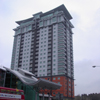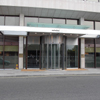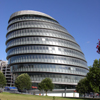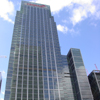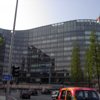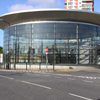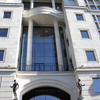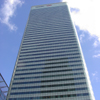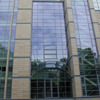Splatter Treatments
Other Services
Cause of the damage
Angle - grinding or welding produces a shower of molten metal particles. If this work is carried out close to glazed areas, the particles can bury themselves in the surface of the glass. When exposed to rain the steel fragments rust, often resulting in an unsightly stain. The glass surface will also be pitted. The severity of the problem usually depends on particle size and the impact distance.
Splatter treatments method
Up to three stages may be required to restore the glass to an acceptable condition. The first stage is to remove the residual metal and other contaminants by employing a complementary chemical and mechanical treatment.
The second stage involves the optical polishing of the damaged area with glass polish to smooth the edges of the pitting caused by the particles. Lastly and only if the surface is heavily damaged, a further treatment may be necessary utilising the techniques employed in the REFACE Glass Scratch Removal process.
Surfaces suitable for treatment
The Reface process can be used on any type of flat glass such as:
- toughened
- float
- plate
- laminated
- armoured
- fire retardant
- heat treated
- radiation
- and other specialised glass.
The process can also be used on curved glass.
As the technique is based on re-surfacing the glass, the process cannot be applied to textured glass, or glass with a surface coating on the damaged side.
Performance
It is unlikely that glass damaged in this way can be restored to perfect condition. However, a significant improvement in appearance can be achieved and normally one that is to required visual standards.
Resin repairs
For deep impact repairs
Where glazing damage involves surface glass missing to a depth greater than approximately 0.2mm, repairs cannot be undertaken using the scratch removal technique, as this would require the removal of too much glass.
The solution is to replace the missing glass with a synthetic resin, which has a refractive index to match that of the glass. The most suitable are acrylates, of which Perspex is probably the best known. Acrylates have excellent clarity, suitable hardness and high impact resistance. They do not degrade, or yellow in sunlight and are cured using ultraviolet light.
Method of treatment
The REFACE Resin-Implant process involves a three-stage repair process. To ensure a strong bonding surface, the glass is first chemically cleaned in and around the damaged area. The liquid resin is then applied to the damaged area and cured. Finally the repaired area is polished to blend the resin in with the glass surface.
Surfaces suitable for treatment
All types of glass in general architectural use can be treated using the Resin-Implant process. For armoured glass, or glass in critical fire-resistant situations, it may be necessary to consult the glass manufacturer.
Performance
Differences in refractive index between the glass and the resin may make repairs visible when viewing a distant object through the glass. When viewed by reflected light, slight differences in the degree of polish between the glass and resin may also be visible.
Stainless steel
Many items in buildings are manufactured from brushed finished stainless steel. Lift doors and surrounds, internal lift panelling, entrance barriers, handrails, glazing support mullions and rails, kitchen and bathroom fittings, worktops and appliances. Although stainless steel is a hard metal surface, accidental scratching can cause unsightly damage. Very often the method of installation can mean that replacement of the damaged panel is difficult and can be costly. REFACE™ will remove the scratch and re-brush the surface to an even finish. There is a limitation to this process; we are unable to work closer than 25 mm from internal corners, some fitments and in some circumstances sink bowls. Also we cannot at present re-polish mirror finish stainless steel, but we are working on development of a suitable process. |

